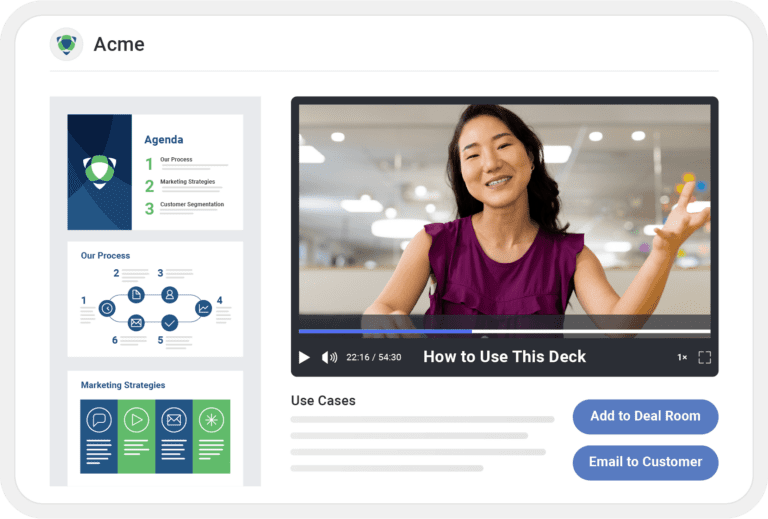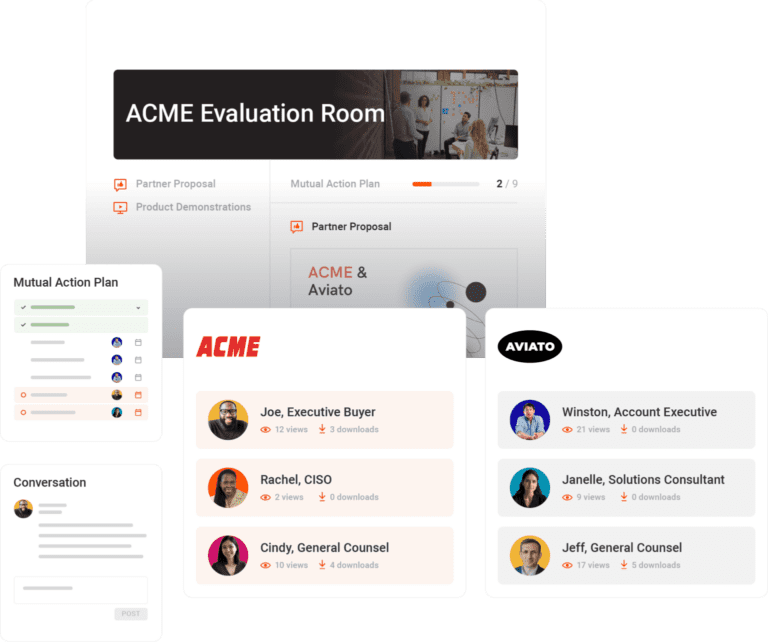What is Sales Collateral and How Does it Help Reps Close More Deals?
![]() Christian Pieper
on
January 25, 2024
Christian Pieper
on
January 25, 2024
Any organization aiming to grow revenue must make sales engagement a priority. When buyers are engaged, they’re more likely to advance through the sales funnel – and make a purchase.
In order to engage buyers, sales reps must deliver the right information at the right time.
The right sales collateral is essential.
In this post, we’ll explore what sales collateral is, why it’s important, and what the different types are. We’ll also share some tips and best practices for creating more effective sales content that’ll help your reps close more deals.
What is sales collateral and why is it important?
First things first: what is sales collateral?
It’s any type of asset that enables sales reps to engage prospects and guide them through the sales funnel. It takes many forms, which we’ll explore in detail a little later on.
Digital
Internal
External
Print vs. digital sales collateral
Today, some organizations continue to use printed sales assets. However, the vast majority of sales organizations are transitioning to digital collateral. This is especially true in today’s world, when many sales are conducted without a buyer and seller ever meeting face-to-face.
A best practice is to leverage a sales content management solution to centralize your digital collateral.
Internal vs. external sales collateral
Some sales collateral is used externally. In other words, this collateral is shared with customers and prospects. Some examples include case studies and data sheets.
Other collateral is for internal use only. This collateral (often referred to as sales enablement collateral) is developed only for use by the sales team. Some examples of internal collateral include sales playbooks and sales battlecards.
The importance of sales collateral
Now, we’re clear on what sales collateral is. But why is it important?
Sales collateral drives sales effectiveness and sales efficiency. When it’s done well, it engages buyers with the right information at the right time in the right format. Outstanding collateral can accelerate the sales cycle, which means sales reps can close deals faster. When reps can close more deals, your revenue will grow.
What are the different types of sales collateral?
There are many different types of sales and marketing collateral. Each type is especially effective in certain parts of the purchase journey. For example, a case study may be impactful for a prospect who is close to making a decision – but first wants to get a better idea of how other businesses have leveraged a similar solution to achieve their goals. However, the same case study may not resonate with prospects who are higher up in the funnel and just starting to research their options.
With that in mind, let’s take a look at the different stages of the sales journey – and some of the best collateral for each stage.
Sales and marketing collateral for the awareness stage
During the awareness stage, prospective customers are aware that they have a challenge (or multiple challenges), and they’ve started to look for solutions to address it. B2B collateral is an important tool that helps ensure prospects become aware of your company and its solutions.
The purpose of collateral at this stage is to make your brand known – and demonstrate that your business is a thought leader. Some common types of collateral that resonate during the awareness stage include:
Blogs are a great way to demonstrate your thought leadership during the awareness phase.
Videos can convey key information in a format that’s easy to digest.
Enables prospects to see what’s new at your organization.
These are a great way to quickly convey a lot of information in an easy-to-digest format.
Regularly posting on key social media channels can increase prospects’ awareness of your brand.
Sales and marketing collateral for the consideration stage
During the consideration stage, prospects start weighing their options. They know about your organization and may have some knowledge about your products and services. But they’re not ready to sign on the dotted line just yet.
Collateral can help sellers build relationships and deliver value during the consideration phase with assets including:
These can be an effective way to present a large amount of information.
eBooks and guides are popular ways to add value during the consideration stage.
Conducting surveys – and then summarizing your findings in a research report – is a powerful way to earn prospects’ trust.
Webinars are an interactive way to share a variety of information and data with prospects.
At this stage, sellers should be sure to use B2B sales content that is industry-specific and speaks to the buyer’s specific challenges.
Sales and marketing collateral for the decision-making stage
At this stage, prospects are getting ready to buy. They’re likely considering your business – as well as a few competitors. The right collateral can build their confidence about your solution being the best option. Collateral that’s effective during the decision-making stage includes:
You can put together fact sheets to concisely convey key product information.
Tells the story of how a company has leveraged your solution to solve their challenges.
These customer quotes give prospects an idea of what it’s like to work with your company.
Provides prospects with concise feedback from your current customers.
Tools like ROI calculators can help prospects understand what they can expect from investing in your products or services.
Demos enable buyers to see your solution in action.
Sales and marketing collateral for retention stage
After you’ve closed a deal, the goal is to keep that customer around long-term. After all, retaining an existing customer is a whole lot easier (and less expensive) than acquiring a new one.
This can be a great way to share best practices to ensure customers are getting the most value from your solution.
Let customers know what’s new with your product and how it benefits them.
Newsletters are a great way to share what’s new at your company. They can also include links to other resources that’ll build customers’ knowledge and ensure they’re getting the most from your solutions.
You can engage customers by sending automated emails when they complete certain activities.
How do you create sales collateral for your business?
The right sales collateral can help you grow revenue. But creating collateral for the sake of creating collateral isn’t effective. After all, research suggests that up to 70% of B2B sales collateral sits unused.
Asking key questions for sales content development
It’s important to create collateral that resonates with buyers throughout the purchase journey – and is proven to move deals forward. It’s also imperative to ensure sellers know where to find the collateral they need – as well as how to use it.
So, how can you start creating more effective collateral for your team? The first, foundational step is to answer these five questions:
Question #1: Who is your customer?
Before developing any type of asset, you must have a clear understanding of who you are talking to. Today, many sales organizations develop buyer personas. Buyer personas are detailed descriptions of fictitious prospects who are a good fit for your organization’s products or services.
Question #2: What are your customers’ pain points?
Generic B2B sales content isn’t effective. Instead, it must speak to a customer’s specific pain points.
When developing your buyer personas, it’s important to understand their challenges. That way, you can develop sales content that specifically addresses those pain points.
Question #3: How can prospects trust your solution?
To close deals, you must articulate why your solution is the best option for solving your customers’ challenges.
Of course, it’s important to establish your brand messaging. However, incorporating the voices of your existing customers into your sales content can be a powerful way to earn prospects’ trust.
A recent Gartner study found that “third-party interactions, such as reading customer references or reviews and consulting directly with third-party experts, are better suited to provide customers with value affirmation.”
Question #4: What types of content will help in the buyer journey?
You know who your customers are and you understand their pain points. You also understand how your solution is ideal to address those pain points. Next, you have to determine what types of content are right for delivering your message throughout the purchase journey.
There’s no right answer here. As we discussed earlier, different types of sales collateral resonate with buyers at different points in the purchase journey. It’s important to determine the right mix of sales assets, measure regularly, and optimize accordingly.
Question #5: How can you retain your existing customers?
Often, sales content is focused on acquiring new customers. However, it’s also important to develop collateral that aids in customer retention.
It’s important to ask yourself what you need to keep your customers around long-term. Then, develop the right content to engage them.
You can use the answers to these key questions to develop the right sales collateral.
Streamlining management
You’ve answered the key questions above and used the answers to develop sales collateral. What now?
It’s important to ensure your sellers know how to find and use your newly created sales content.
At some sales organizations, collateral is stored in multiple repositories or distributed by email. This makes it difficult for sellers to find the sales assets they need in a specific situation. In addition, it’s common for sellers to use outdated content.


A best practice is to store and organize your sales collateral in a single platform. Many revenue enablement solutions include content management functionality so you can store all content in one place. That way, sales reps can easily find the best content for any selling scenario.
In addition, sales enablement teams must provide training to ensure sellers know when and how to use the sales collateral that’s available to them.
Measuring and optimizing
Sometimes, organizations develop a piece of sales collateral, upload it to a repository, and then never think about it again. This isn’t an effective approach.
Instead, it’s important to consistently measure usage of sales collateral. In other words, how often are sellers using a specific piece of sales collateral? And how are buyers engaging with it?
It’s also important to measure how (or whether) sales collateral is impacting sales outcomes. That way, you can understand which collateral has the biggest impact – and focus your efforts on those assets.
Increase the impact of your sales collateral with Mindtickle
Sales collateral – when it’s done well – can be a powerful tool for engaging buyers throughout the sales cycle. When sales reps are able to engage a buyer, they’re more likely to close a deal.
But generic collateral won’t cut it. Instead, organizations must equip sellers with content that resonates with buyers and is proven to improve sales outcomes. In addition, organizations must ensure this sales content is easy to find and that sales reps know how to use it.
Mindtickle’s revenue productivity platform incorporates sales content management, which enables organizations to centralize their collateral. That means sales reps can easily find the right sales content for any selling scenario. In addition, sales leadership can easily measure how collateral is being used and whether it’s improving sales outcomes.
Of course, it’s important to ensure sellers know how to use sales collateral. Mindtickle also enables organizations to deliver sales training and sales enablement to ensure sellers know how and when to use the sales assets that are available to them.
Sales Content Management in Mindtickle
Ready to see how Mindtickle’s award-winning sales productivity platform ensures reps are always ready to sell?
Request a Demo



